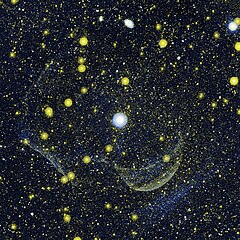Śatabhiszak (nakszatra)
| ||
 | ||
| Władca | Rahu | |
| Symbol | sto gwiazd | |
| Zwierzęcy symbol | koń | |
| Bóstwo | Waruna, bóg morza | |
| Motywacja | Dharma | |
| Trójnia gun | Sattwa, Tamas, Sattwa | |
| Kolor | seledynowy | |
| Kierunek | Południe | |
| Sylaby | Go, Sa, Se, So | |
| Gwiazda | Sa'd-al-Akhbiyah | |
| Zachodni znak | Wodnik i Ryby | |
Śatabhiszak lub też Śatataraka (Dewanagari: शतभिषक् / शततारका) – nakszatra, rezydencja księżycowa. Termin używany w astrologii dźjotisz do określenia części Zodiaku, która położona jest w dwóch znakach - Wodniku i Rybach.
Śata oznacza sto a bhiszak - demony lub uzdrowiciele[1].
Śatabhiszak jako czas charakteryzuje się niespokojną, mentalną energią[2].
Przypisy
Media użyte na tej stronie
This composite image shows Z Camelopardalis, or Z Cam, a double-star system featuring a collapsed, dead star, called a white dwarf, and a companion star, as well as a ghostly shell around the system. The massive shell provides evidence of lingering material ejected during and swept up by a powerful classical nova explosion that occurred probably a few thousand years ago.
The image combines data gathered from the far-ultraviolet and near-ultraviolet detectors on NASA's Galaxy Evolution Explorer on Jan. 25, 2004. The orbiting observatory first began imaging Z Cam in 2003.
Z Cam is the largest white object in the image, located near the center. Parts of the shell are seen as a lobe-like, wispy, yellowish feature below and to the right of Z Cam, and as two large, whitish, perpendicular lines on the left.
Z Cam was one of the first known recurrent dwarf nova, meaning it erupts in a series of small, "hiccup-like" blasts, unlike classical novae, which undergo a massive explosion. That's why the huge shell around Z Cam caught the eye of astronomer Dr. Mark Seibert of Carnegie Institution of Washington in Pasadena, Calif. -- it could only be explained as the remnant of a full-blown classical nova explosion. This finding provides the first evidence that some binary systems undergo both types of explosions. Previously, a link between the two types of novae had been predicted, but there was no evidence to support the theory.
The faint bluish streak in the bottom right corner of the image is ultraviolet light reflected by dust that may or may not be related to Z Cam. Numerous foreground and background stars and galaxies are visible as yellow and white spots. The yellow objects are strong near-ultraviolet emitters; blue features have strong far-ultraviolet emission; and white objects have nearly equal amounts of near-ultraviolet and far-ultraviolet emission.